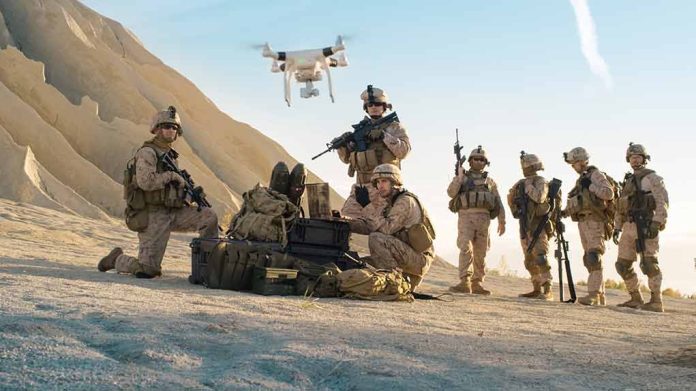🔴 Website 👉 https://u-s-news.com/
Telegram 👉 https://t.me/usnewscom_channel
The US Army has slashed costs by 90% with revolutionary 3D-printed surveillance drones that detect invisible threats, outmaneuvering both bureaucratic hurdles and foreign dependence on components.
Key Takeaways
- US Army’s 2nd Multi-Domain Effects Battalion has developed 3D-printed drones that cost only $2,000-$3,000 compared to traditional $28,000 military drones
- These innovative drones detect electromagnetic signatures from cell phones, WiFi, and radar systems that cameras alone cannot see
- On-site manufacturing capabilities reduce dependency on foreign-made components and accelerate battlefield deployment
- Despite bureaucratic delays of 90-120 days for approvals, the team has completed over ten successful field trials
- The technology will undergo operational testing in Poland to evaluate its effectiveness in identifying simulated threats
Battlefield Innovation at Fraction of the Cost
In a major advancement for military technology, the US Army is field-testing 3D-printed surveillance drones that cost just one-tenth of traditional models. Soldiers from the 2nd Multi-Domain Effects Battalion stationed in Germany have engineered these cutting-edge drones that can detect invisible electromagnetic threats on the battlefield. While traditional military-grade drones often cost upwards of $28,000 each, these innovative 3D-printed versions cost between $2,000 and $3,000, delivering sophisticated capabilities at a fraction of the price while reducing America’s dependency on foreign-manufactured components.
The development process required extensive engagement with 3D printing technology to ensure durability and a lightweight design suitable for battlefield operations. These drones aren’t just cheaper alternatives – they’re specifically designed to detect electromagnetic signatures that visual surveillance cannot capture, giving American forces a critical advantage in identifying potential threats before they become visible through conventional means. This capability represents a significant leap forward in battlefield intelligence gathering and situational awareness.
Detecting the Invisible Enemy
Unlike conventional camera-equipped drones, these sophisticated units are designed to detect and map electromagnetic signatures from cell phones, routers, WiFi networks, and radar systems. This capability provides crucial intelligence about enemy positions and activities that would otherwise remain hidden from visual surveillance. The technology essentially allows military commanders to “see” the electronic footprint of adversary forces, even when those forces are attempting to remain physically concealed.
“The main way I see adversaries is through their electromagnetic signature,” said Lt. Col. Aaron Ritzema, commander of the 2nd Multi-Domain Effects Battalion. “What I want to do is replicate what one of those adversary capabilities would look like in the spectrum.”
The upcoming military exercise in Poland will put these drones to the test in identifying simulated threats and providing actionable intelligence to field commanders. By mapping the electronic battlefield, these drones give American forces the ability to locate and counter enemy communications, command centers, and electronic warfare assets. This capability is increasingly crucial in modern warfare, where information dominance often determines battlefield success.
Overcoming Bureaucracy and Supply Chain Challenges
The development team faced significant challenges beyond the technical aspects of creating these drones. Bureaucratic hurdles within the Department of Defense required between 90 to 120 days for approval and funding processes, considerably slowing down the innovation cycle. Additionally, restrictions on procuring electronic components from certain countries – particularly China – created supply chain difficulties and increased costs. Despite these obstacles, the battalion’s innovation lab persevered through self-teaching and creative problem-solving.
“When we stumbled upon an issue, either we sourced to friends and partners for a solution, or we spent a copious amount of hours self-studying to develop a solution on our own,” he told Task & Purpose.”
While initial tests encountered failures, continuous improvements have brought the project to operational testing readiness. Chief Warrant Officer 2 Chris Lehr described the project as still a “work in progress” but acknowledged the critical need these drones fulfill. The Army faces a persistent shortage of drone assets on the front lines, making this cost-effective solution potentially transformative for battlefield operations. This practical approach to innovation demonstrates the ability of American military personnel to overcome obstacles with ingenuity and determination.
The Future of Military Manufacturing
The success of this 3D-printed drone initiative could revolutionize how the US military approaches equipment procurement and deployment. By enabling on-site manufacturing of mission-specific drones, the Army gains unprecedented flexibility to adapt to changing battlefield conditions without lengthy supply chains. The US Army Futures Command is already exploring the potential for autonomous mass production of drones using additive manufacturing technologies, which could dramatically reduce costs while increasing battlefield responsiveness.
“What we know to be true now is that there are never enough drones. There’s never enough of them on the forward line of troops. There’s never enough of them in production, ” said Chief Warrant Officer 2 Chris Lehr
Military analysts suggest that procurement procedures may need significant overhauls to fully capitalize on the potential of 3D printed equipment. The current paperwork-intensive process creates delays that undermine the inherent speed advantages of on-site manufacturing. As battlefield conditions continue to evolve rapidly, particularly with the proliferation of electronic warfare capabilities among potential adversaries, the ability to quickly produce and deploy specialized detection equipment will become increasingly vital to American military success.
